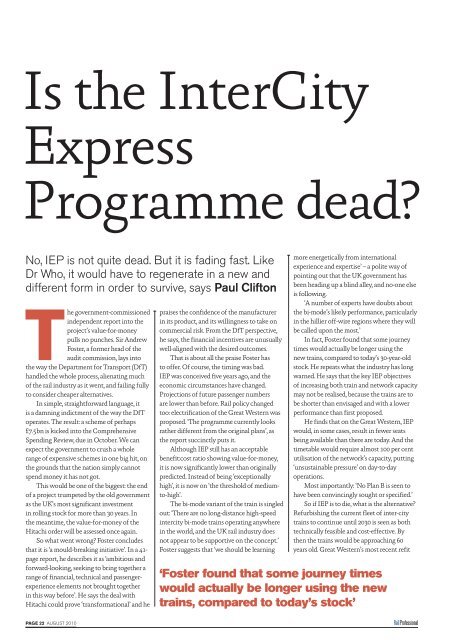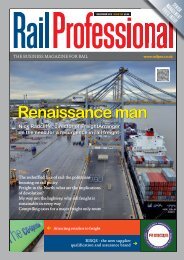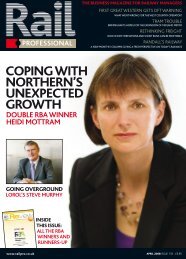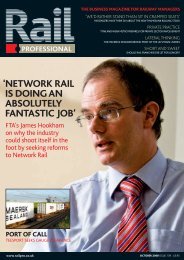View as PDF - Rail Professional
View as PDF - Rail Professional
View as PDF - Rail Professional
Create successful ePaper yourself
Turn your PDF publications into a flip-book with our unique Google optimized e-Paper software.
Is the InterCity<br />
Express<br />
Programme dead?<br />
No, IEP is not quite dead. But it is fading f<strong>as</strong>t. Like<br />
Dr Who, it would have to regenerate in a new and<br />
different form in order to survive, says Paul Clifton<br />
The government-commissioned<br />
independent report into the<br />
project’s value-for-money<br />
pulls no punches. Sir Andrew<br />
Foster, a former head of the<br />
audit commission, lays into<br />
the way the Department for Transport (DfT)<br />
handled the whole process, alienating much<br />
of the rail industry <strong>as</strong> it went, and failing fully<br />
to consider cheaper alternatives.<br />
In simple, straightforward language, it<br />
is a damning indictment of the way the DfT<br />
operates. The result: a scheme of perhaps<br />
£7.5bn is kicked into the Comprehensive<br />
Spending Review, due in October. We can<br />
expect the government to crush a whole<br />
range of expensive schemes in one big hit, on<br />
the grounds that the nation simply cannot<br />
spend money it h<strong>as</strong> not got.<br />
This would be one of the biggest: the end<br />
of a project trumpeted by the old government<br />
<strong>as</strong> the UK’s most significant investment<br />
in rolling stock for more than 30 years. In<br />
the meantime, the value-for-money of the<br />
Hitachi order will be <strong>as</strong>sessed once again.<br />
So what went wrong? Foster concludes<br />
that it is ‘a mould-breaking initiative’. In a 41-<br />
page report, he describes it <strong>as</strong> ‘ambitious and<br />
forward-looking, seeking to bring together a<br />
range of financial, technical and p<strong>as</strong>sengerexperience<br />
elements not brought together<br />
in this way before’. He says the deal with<br />
Hitachi could prove ‘transformational’ and he<br />
praises the confidence of the manufacturer<br />
in its product, and its willingness to take on<br />
commercial risk. From the DfT perspective,<br />
he says, the financial incentives are unusually<br />
well-aligned with the desired outcomes.<br />
That is about all the praise Foster h<strong>as</strong><br />
to offer. Of course, the timing w<strong>as</strong> bad.<br />
IEP w<strong>as</strong> conceived five years ago, and the<br />
economic circumstances have changed.<br />
Projections of future p<strong>as</strong>senger numbers<br />
are lower than before. <strong>Rail</strong> policy changed<br />
too: electrification of the Great Western w<strong>as</strong><br />
proposed. ‘The programme currently looks<br />
rather different from the original plans’, <strong>as</strong><br />
the report succinctly puts it.<br />
Although IEP still h<strong>as</strong> an acceptable<br />
benefit:cost ratio showing value-for-money,<br />
it is now significantly lower than originally<br />
predicted. Instead of being ‘exceptionally<br />
high’, it is now on ‘the threshold of mediumto-high’.<br />
The bi-mode variant of the train is singled<br />
out: ‘There are no long-distance high-speed<br />
intercity bi-mode trains operating anywhere<br />
in the world, and the UK rail industry does<br />
not appear to be supportive on the concept.’<br />
Foster suggests that ‘we should be learning<br />
more energetically from international<br />
experience and expertise’ – a polite way of<br />
pointing out that the UK government h<strong>as</strong><br />
been heading up a blind alley, and no-one else<br />
is following.<br />
‘A number of experts have doubts about<br />
the bi-mode’s likely performance, particularly<br />
in the hillier off-wire regions where they will<br />
be called upon the most.’<br />
In fact, Foster found that some journey<br />
times would actually be longer using the<br />
new trains, compared to today’s 30-year-old<br />
stock. He repeats what the industry h<strong>as</strong> long<br />
warned. He says that the key IEP objectives<br />
of incre<strong>as</strong>ing both train and network capacity<br />
may not be realised, because the trains are to<br />
be shorter than envisaged and with a lower<br />
performance than first proposed.<br />
He finds that on the Great Western, IEP<br />
would, in some c<strong>as</strong>es, result in fewer seats<br />
being available than there are today. And the<br />
timetable would require almost 100 per cent<br />
utilisation of the network’s capacity, putting<br />
‘unsustainable pressure’ on day-to-day<br />
operations.<br />
Most importantly: ‘No Plan B is seen to<br />
have been convincingly sought or specified.’<br />
So if IEP is to die, what is the alternative?<br />
Refurbishing the current fleet of inter-city<br />
trains to continue until 2030 is seen <strong>as</strong> both<br />
technically fe<strong>as</strong>ible and cost-effective. By<br />
then the trains would be approaching 60<br />
years old. Great Western’s most recent refit<br />
‘Foster found that some journey times<br />
would actually be longer using the new<br />
trains, compared to today’s stock’<br />
PAGE 22 AUGUST 2010
















